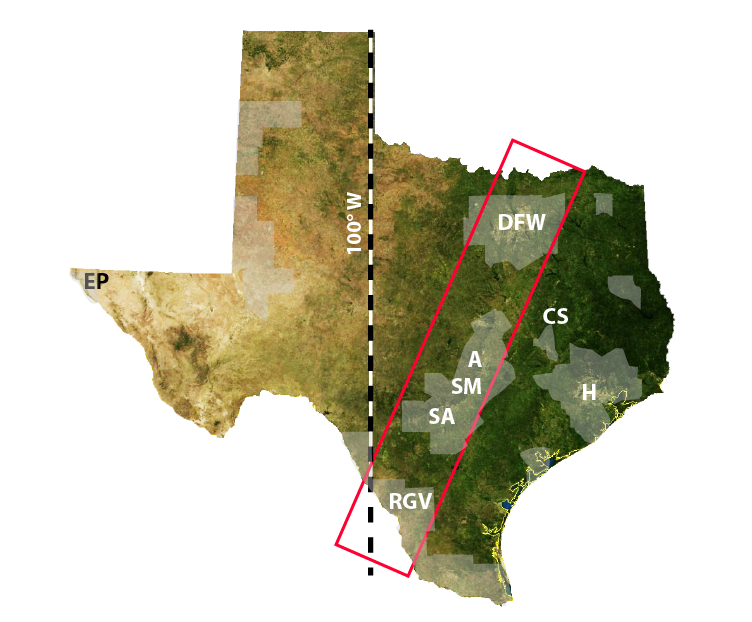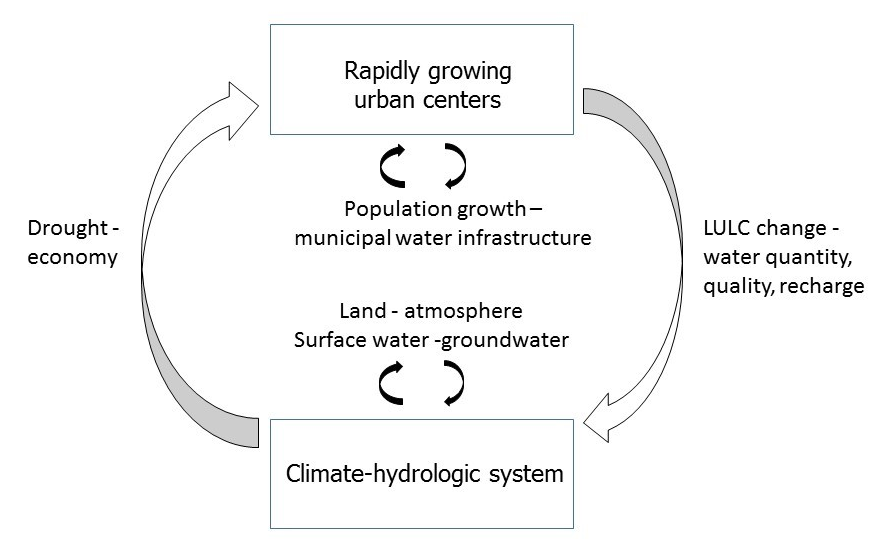Texas Water Research Network
Water of sufficient quantity and quality for Texas is of the utmost importance. This includes water for people, for energy, for agriculture, for the environment, and for the economy. There is a clear need for investment in water infrastructure, $63 billion over the next 50 years, for water conservation and for the development of new sources of water (2017 TWDB State Water Plan). Beyond these infrastructure costs, there is also a need to gather the best data and to develop the best science to determine:
- The natural and human processes that affect the distribution of water in the state today and for the 21st century,
- The technologies for increasing our water supply or decreasing water demand; and
- The impact of the growth of Texas’ population, economy, and energy requirements on Texas water.
Along with numerous partners, the Environmental Science Institute at The Univ. of Texas at Austin is leading an effort to better understand and to address the grand challenges of water availability in Texas, for today and for the future.
Join the Texas Water Research Network
This effort is supported by the Cynthia and George Mitchell Foundation and the National Science Foundation.
Our mission is to facilitate:
- Collaborative scientific research on the nexus of changing water availability and rapidly growing urban corridors; and
- Collaboration and communication linking science and policy to advance Texas water resilience.
The Texas Water Research Network provides a forum and encouragement for research about water science, management, and policy. Solutions to Texas’ water challenges will be addressed through new knowledge, innovative approaches, as well as through the synthesis of existing knowledge. This is of special significance for Texas water challenges related to the rapid population growth and projected changing water availability in the state in the 21st Century.
The Leadership Team draws on the experience and expertise of established researchers and stakeholders related to Texas water resources. The Leadership Team will provide broad perspective and guidance to shape the focus and direction of the Texas Water Research Network.
| Name | University | Department/Institute | Expertise |
| Jay Banner | Univ. of Texas at Austin | Environmental Science Institute & Department of Geological Sciences | CO, WH, M |
| Jude Benavides | Univ. of Texas at Rio Grande Valley | Chemistry and Environmental Sciences | WH |
| Mateo Scoggins | City of Austin | Watershed Protection Department | WH |
| Lynn Katz | Univ. of Texas at Austin | Civil, Architectural, and Environmental Engineering | WH |
| Kevin Kloesel | Univ. of Oklahoma | Atmospheric and Geographic Sciences | CO, MC |
| Bruce McCarl | Texas A&M Univ. | Agricultural Economics and Texas AgriLife | A, SE |
| John Nielsen-Gammon | Texas A&M Univ. | Atmospheric Sciences, State Climatologist | CO, MC |
| Suzanne Pierce | Univ. of Texas at Austin | Texas Advanced Computer Center &Environmental Science Institute | DS, WP, WH, SH |
| Lloyd Potter | Univ. of Texas at San Antonio | Dept. Demography & Inst. for Demographic and Socioeconomic Research, State Demographer | D, SE, M |
| Andrew Sansom | Texas State Univ. | Meadows Center for Water & the Environment | WH, M |
| Suzanne Schwartz | Univ. of Texas at Austin | School of Law & Center for Public Policy Dispute Resolution | WP, L, SH, M |
| Venkatesh Uddameri | Texas Tech Univ. | Civil & Environmental Engineering and Water Resources Center | WH, M |
| Todd Votteler | Collaborative Water Resolution | Resource Policy and Stewardship | WP, SH, WH |
| Michael Young | Univ. of Texas at Austin | Bureau of Economic Geology | WH |
Expertise Key:
| A = Agriculture | LU = Land Use-Land Cover | SH = Stakeholder Engagement |
| CO = Climate Observations | M = Project Management | WH = Water/Hydrology |
| D = Demography | MC = Meteorology/Climate Modeling | WP = Water Policy |
| DS = Decision Support | R = Regional Planning | |
| L = Law | SE = Socioeconomics |
The Facilitation Team includes a subset of members from the Leadership Team, along with others needed to actively implement the vision outlined by the Leadership Team.
| Name | Institution | Department | Expertise |
| Jay Banner | Univ. of Texas at Austin | Environmental Science Institute & Department of Geological Sciences | CO, WH, M |
| Jose Abella-Gutierrez | Univ. of Texas at Austin | Environmental Science Institute | WH, CO, M |
| Patrick Bixler | Univ. of Texas at Austin | LBJ School of Public Affairs | SH, DS, WP |
| Cole Ruiz | Lloyd Gosselink Rochelle & Townsend | Environmental Science Institute & Department of Geological Sciences | WH L |
| Robert Mace | Texas State Univ. | Meadows Center for Water and the Environment | WP, SH, M |
| Josh Katz | Bickerstaff, Heath, Delgado, Acosta LLP | WH L | |
| Travis Albrecht | Gensler | Architecture, Sustainable Cities | LU M |
Expertise Key:
| A = Agriculture | LU = Land Use-Land Cover | SH = Stakeholder Engagement |
| CO = Climate Observations | M = Project Management | WH = Water/Hydrology |
| D = Demography | MC = Meteorology/Climate Modeling | WP = Water Policy |
| DS = Decision Support | R = Regional Planning | |
| L = Law | SE = Socioeconomics |
The Environmental Justice (EJ) Committee includes a subset of members from the Facilitation Team, along with others whose research and professional interests have ultimately led to their deep engagement in issues of underserved communities. The EJ Committee leads the conversation and engagement activities from a multitude of perspectives and advises the Facilitation Team to position the TWRN as a service-oriented network.
| Name | Institution | Department | Expertise |
| Jose Abella-Gutierrez | Univ. of Texas at Austin | Environmental Science Institute | WH, CO, M |
| Patrick Bixler | Univ. of Texas at Austin | LBJ School of Public Affairs | SH, DS, WP |
| Tianna Bruno | Univ. of Texas at Austin | Department of Geography | WH, CO, SH |
| Leah Turner | Univ. of Texas at Austin | Geological Sciences, GeoFORCE Program | SH, SE, DS |
| Chu-Ling Chen | Univ. of Texas Rio Grande Valley | Environmental Earth Sciences, Civil Engineering | WH, SH, R |
| Ali Fares | Prarie View A&M Univ. | College of Agriculture and Human Sciences | WH, WP, A, SE |
| Margaret Cook | Houston Advanced Research Center | Architecture, Sustainable Cities | WH, CO, WP, SH |
Expertise Key:
| A = Agriculture | LU = Land Use-Land Cover | SH = Stakeholder Engagement |
| CO = Climate Observations | M = Project Management | WH = Water/Hydrology |
| D = Demography | MC = Meteorology/Climate Modeling | WP = Water Policy |
| DS = Decision Support | R = Regional Planning | |
| L = Law | SE = Socioeconomics |
The New 100th Meridian: Urban Water Resiliency in a Climatic and Demographic Hot Spot
The University of Texas at Austin Environmental Science Institute was awarded a five-year, $500,000 grant from the National Science Foundation’s Coupled Natural and Human Systems program. The grant runs from 2015 through 2020 and includes Principal Investigators from:
Univ. of Texas at Austin – Jay Banner (Dept. of Geological Sciences) & Suzanne Pierce (Texas Advanced Computing Center)
Texas A&M Univ. – John Nielsen-Gammon (Dept. of Atmospheric Sciences)
Texas Tech Univ. – Venkatesh Uddameri (Dept. of Civil, Environmental, and Construction Engineering)
Univ. of Texas at San Antonio – Lloyd Potter (College of Public Policy).
The interdisciplinary project team includes faculty and researchers from multiple universities in Texas and beyond, along with stakeholders from diverse backgrounds and interests – agriculture, water policy, science and engineering, climatology, demography, urban planning, energy, decision support, socioeconomics, land use-land cover, and hydrology.
The project seeks to develop:
- Regional climate projections and mechanisms, including assessing regional climate projections from global models and downscaled dynamical–statistical models;
- 21st century scenarios of population, urbanization, climate change, and flow regulation impacts on hydrology and water availability; and
- An understanding of impacts on stakeholders.
For more details, check out the project abstract.

